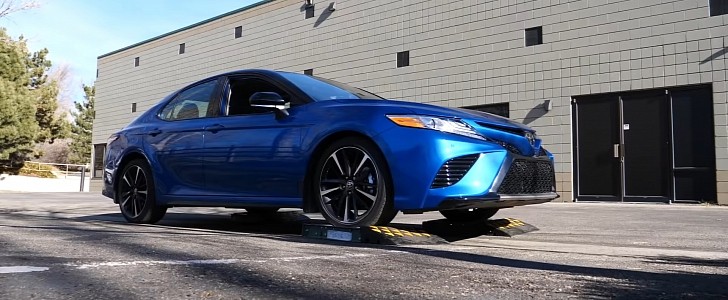Increasing demand for sport utility vehicles is why passenger cars aren’t as lucrative for the automotive industry as they used to be not that long ago. This trend has also given us faux crossovers, but Toyota went down a different route by adding all-wheel drive to the Camry and Avalon.
The pressing question is, does this AWD system cut the mustard where it really matters? Our friends at The Fast Lane wanted to find out, and the Camry with all-wheel drive hasn’t failed to impress in the slip test.
Getting various wheels stuck on rollers is an efficient way to find out how the all-wheel-drive system and the traction control fare in slippery conditions. As opposed to the e-AWD of the Prius hatchback and RAV4 Prime crossover, the Camry AWD tested by The Fast Lane utilizes an electromagnetic coupling on the front of the rear-drive axle that engages or disengages automatically.
The Japanese automaker has simply borrowed the all-wheel-drive system from the RAV4 and modified the floor structure to accommodate AWD. The parking brake's design has also been changed, and Toyota switched to a saddle-style fuel tank instead of the flat fuel tank of the front-driven model.
Even in the three-wheel and diagonal slip tests, the mid-size sedan didn’t break a sweat thanks to clever engineering and well-calibrated software.
“The other great thing about this Camry is the real transmission,” said Tommy Mica, referring to a torque-converter automatic with eight forward ratios instead of the continuously variable transmission of the Prius e-AWD. Also worthy of note, Subaru loves CVTs, too, even though it’s a design that hinders a great AWD system and takes away from the driving experience.
Capable of channeling 50 percent of the engine’s torque to the rear wheels, AWD is available from $26,370 for the Camry LE and $35,875 for the Avalon XLE. Both models feature a 2.5-liter Dynamic Force four-cylinder engine with more than 200 horsepower and 180 pound-feet (243 Nm) of torque on tap.
Getting various wheels stuck on rollers is an efficient way to find out how the all-wheel-drive system and the traction control fare in slippery conditions. As opposed to the e-AWD of the Prius hatchback and RAV4 Prime crossover, the Camry AWD tested by The Fast Lane utilizes an electromagnetic coupling on the front of the rear-drive axle that engages or disengages automatically.
The Japanese automaker has simply borrowed the all-wheel-drive system from the RAV4 and modified the floor structure to accommodate AWD. The parking brake's design has also been changed, and Toyota switched to a saddle-style fuel tank instead of the flat fuel tank of the front-driven model.
Even in the three-wheel and diagonal slip tests, the mid-size sedan didn’t break a sweat thanks to clever engineering and well-calibrated software.
“The other great thing about this Camry is the real transmission,” said Tommy Mica, referring to a torque-converter automatic with eight forward ratios instead of the continuously variable transmission of the Prius e-AWD. Also worthy of note, Subaru loves CVTs, too, even though it’s a design that hinders a great AWD system and takes away from the driving experience.
Capable of channeling 50 percent of the engine’s torque to the rear wheels, AWD is available from $26,370 for the Camry LE and $35,875 for the Avalon XLE. Both models feature a 2.5-liter Dynamic Force four-cylinder engine with more than 200 horsepower and 180 pound-feet (243 Nm) of torque on tap.


























